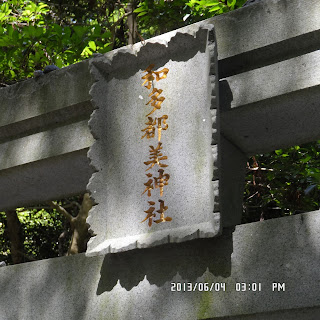Date: June 4, 2013 (Tue), Fine
Sightseeing Course: Hitakatsu Port – Korea Observatory – Eboshidake Observatory – Wadatsumi Shrine - Tsushima Museum of History and Folklore – Samurai Residence Street – Izuhara Hachiman Shrine – Shuzenji Temple – Manrokaku – Hotel Kanaishikan
Partners: About 40 Koreans
During this semester, I have classes on Monday and Friday. I have never been to Tsushima and I understand that Tshushima has a long deep relationship with Korea. So I decided to join a guided-tour planed by a Korean agent, “Hana Tour.” It is a one-night two-days tour with a Korean speaking guide.
I went to Busan by 8:17 using a taxi and KTX and hurried to International Terminal of Busan Port by 8:30 am. That was the time to meet the tour guide. We were on board at 8:50 at Busan Port.
It took only 70 minutes from Busan to Hitakatsu Port in Tsushima by the Beetle. We arrived at Hitakatsu Port at 10:40.
Since I went through the exit for Japanese, and there were a few Japanese, I could get through the customs quite easily, but not for Korean sightseers. It took nearly one hour to clear all of them. We had lunch at a sushi restaurant near the port.
The menu were very simple: udon noodle and cheapest shushi (oinarisan and norimaki).
Then we went to the first sightseeing spot: Korea Observatory. The direct distance between Korea and Tsushima is only 49.5 km (cf, Kyushu and Tsushima is 132 km). So, Koreans who came to Tsushima, may come to this observatory and see the Korean Peninsula.
When we came to this observatory, the sky or the air between Korean and Tsushima was not clear, so we could not see the peninsula. (I could see Tsushima from Busan when I guided a group of Japanese on April 7 this year.)

[Memorial Stone for those who lost their lives at the sea, 112 Korean translators and officials who were bound to Japan 300 years ago, 朝鮮国訳官及び従者の慰霊塔、조선국 통역관및 수행자들의 위령탑]
Hitakatsu Port is the northern tip of “Kamijima” and the town called Itsuhara is southern most of “Shimojima.” The distance is about 82 km. The guide asked the driver to go through “Momiji” street. It was really a nice street with maple trees along the street.
The next sightseeing spot was “Eboshidake Observatory” where we could have panorama views of Aso Bay(浅茅湾). Aso Bay is famous for its deeply-indented coastline. The guide said it was more beautiful than Ha Long Bay in Viet Nam.
I have never been Ha Long Bay, so I cannot compare, but it was a beautiful scene.
We all walked to the parking lot where there were many azalea flowers in full broom. I saw some Swallowtail butterflies flying around the flowers.
The next spot was “Watatsumi Shrine” where “Toyotama Hime” was enshrined. According to “Kojiki” the oldest extant chronicle in Japan, Toyotama Hime was the daughter of “Sea God” and grandmother of the first emperor “Jinmu.”
The Korean guide, “Yu Hejin” must have studied Japanese culture and history very well. She explained the story of Umihiko-Yamahiko, Kojiki, and Toyotamahime, etc. very well.
We visited the tomb of Toyotama Hime. I saw many Korean currencies devoted to the tomb.
There are five “torii” or “shrine gates”, three of them on land, and two of them in the sea.
After visiting the shrine, we went into “Shimojima” or the lower island, and headed for Itsuhara, the largest city in Tsushima.
We went to The museum of historical documents first. There are about 300,000 documents being kept by the Sou family. The Sou family had been the ruler of the islands during the feudal era.
After visiting the museum, we went to Hachiman Shrine via Bukeyashiki Street.
We could see the houses and walls of feudal era along “Bukeyashiki Street.”
After “Bukeyashiki Street” we visited Izuhara Hachiman Shrine.
According to Wikipedia, Empress Jingu visited “Shimizuyama” after invading Korean peninsula in AD 200, and enshrined the rock on the mountain. Later, Emperor Tenmu ordered to build a shrine at the foot of Shimizuyama and that was the origin of the shrine. There are about 44,000 Hachiman Shrine in Japan. There is a famous Tsurugaoka Hachiman Shrine in Kamakura, too.
After visiting Izuhara Hachiman, the guide took us to “Shuzenji” Temple where there was a memorial stone for “ Choi Ik-hyun.”
http://en.wikipedia.org/wiki/Choi_Ik-hyun
Choi Ik-hyun was one of Korean Joseon Dynasty Neo-Confucianism scholars, who fought against Japanese rule of Korean peninsula and caught and sent to Tsushima. He died of hunger after refusing to eat and food in the prison.
The Shuzenji Temple was the last sightseeing spot of the day. We had supper at Manshoro Restaurant, and I was allocated to a nice hotel room at Kanaishikan apart from other Korean guests.
It was a twin room of single use. So, it was spacious, but there was no refrigerator in the room. Otherwise, it was nice, but I could not use internet in the room.
------------------------------------------------------------------------------------------------
分類:旅行、日本、九州
旅行月日:2013年6月4日(火)晴れ
旅行地:日本、長崎県、対馬
観光コース:比田勝港~韓国展望台~烏帽子岳展望台~和多都美神社~対馬歴史民俗資料館~武家屋敷~厳原八幡宮~修善寺~万楼閣(夕食)~ホテル金石館(対馬市厳原)
同行者:韓国人観光客約40人
授業の無い火・水を利用して一泊二日の韓国人向けのツアー対馬に行くことにした。
新城洞から6時半すぎにタクシーに乗り大田駅まで17分1万500ウォンだった。駅には6時前に到着して30分あまり列車の到着を待った。
6:32発のKTXは8:17の時間通りに到着した。駅前のタクシー乗り場でタクシーに乗り国際旅客ターミナルまで10分弱。ちょうどミーティング時間の8:30にハナツアーの添乗員の前に到着した。
8:50の乗船手続き開始。釜関フェリーと同じ入り口を通ってから長い通路をとおり、ビートルに乗船した。
乗客数はおよそ300人。乗船時間は1時間10分で、9時半出発10時40分、比田勝港に到着した。
税関窓口は2つしかなく、長い列ができたが、日本人は優先ということで、真っ先に税関を通過した。ガイドがバスの番号「61」を通知してくれたのですぐ自分のバスはわかった。しかし、残りのツアー客が時間がかかる。全員がバスに乗ったのは11時30分ごろだった。
昼食は比田勝港のすぐそばの鮨屋の二階で、うどんとお稲荷さんと海苔巻という簡単なもの。
昼食後の最初のスポットは上島(かみじま)の北端にある韓国展望台。展望台付近にはスズメバチの巣があるらしく、注意せよとの警告があったが、駆除はむずかしいのだろうか。
この日は展望台から釜山はみえなかった。韓国展望台のあとはひたすら南の下島へ向かう。
もみじ街道とよばれる杉林の中に道路に沿って紅葉が植えられている街道を通った。ここはガイドが推奨するとおり気持ちの良い街道で、冷房を切って窓を開けて走った。
次のスポットは上島と下島の中間に位置する浅茅湾が展望できる烏帽子岳展望台で、展望台近くの駐車場からかなり急な階段を10分ほど上らねばならない。
展望台からの浅茅湾の展望はじつにすばらしい。リアス式海岸のため入り組んだ海岸線と島々のおりなす風景が美しい。
徒歩で下った先の広場にバスが停まっていて観光客を待っていた。この駐車場の花壇はツツジが満開で、アゲハチョウが舞っていた。
展望台からつづらおりの道路を下った海岸に「和多都美神社」という神社があり、森の中の大木の下に豊玉姫之墳墓と書かれた丸っぽい石があった。
また、ここを訪れる観光客はほとんどが韓国人なのか、お賽銭はみな韓国のコインや千ウォン札だった。
ここでガイドは「海彦山彦」の話をしてくれた。山彦が海神の娘、豊玉姫(トヨタマヒメ)と結婚し、生まれた4人の子供の末っ子が神武天皇の父になるという。
ガイドの「ユ・ヘジン」はよく日本文化を研究していて相撲の手形切りが「心」という字を表しているなど、忘れていたことを思い出させてくれた。
ここの神社は5連の鳥居があり、陸に3つ、海に2つと続いている。
この神社見学の後は下島に入り、厳原へ向かった。厳原ではバスを降り、もっぱら徒歩で各スポットを廻った。
最初は歴史資料館で、このすぐ横が有明山の登山路の入り口になっていた。
歴史資料館の次は武家屋敷を経由して厳原八幡神社で、その由来はウィキペディアによると「神功皇后が三韓征伐からの帰途、対馬の清水山に行啓し、この山は神霊が宿る山であるとして山頂に磐境を設け、神鏡と幣帛を置いて天神地祇を祀ったという。655年(白鳳6年)、天武天皇の命により清水山の麓に社殿を造営して八幡神を祀ったのに始まる。」
神社見学の次は「修善寺」という伊豆と同じ名前の寺を訪問した。ここには七甲山に銅像が建てられていた朝鮮末期の忠臣で対馬で餓死した「崔益鉉」の碑があった。
この「修善寺」訪問の後、旅館「万松楼」で夕食。夕食はかなり豪華にみえる「石焼料理」で、私は600円のビールを1本たのんだ。
夕食後ホテルにチェックインだが、ガイドは私に配慮して、韓国人たちのホテルとは別の金石館にしてくれた。
かなり広めのツインルームでよかったが、冷蔵庫がないことと、LANケーブルを借りてパソコンにつないでもインターネットができなかったのが不満だった。













































0 件のコメント:
コメントを投稿